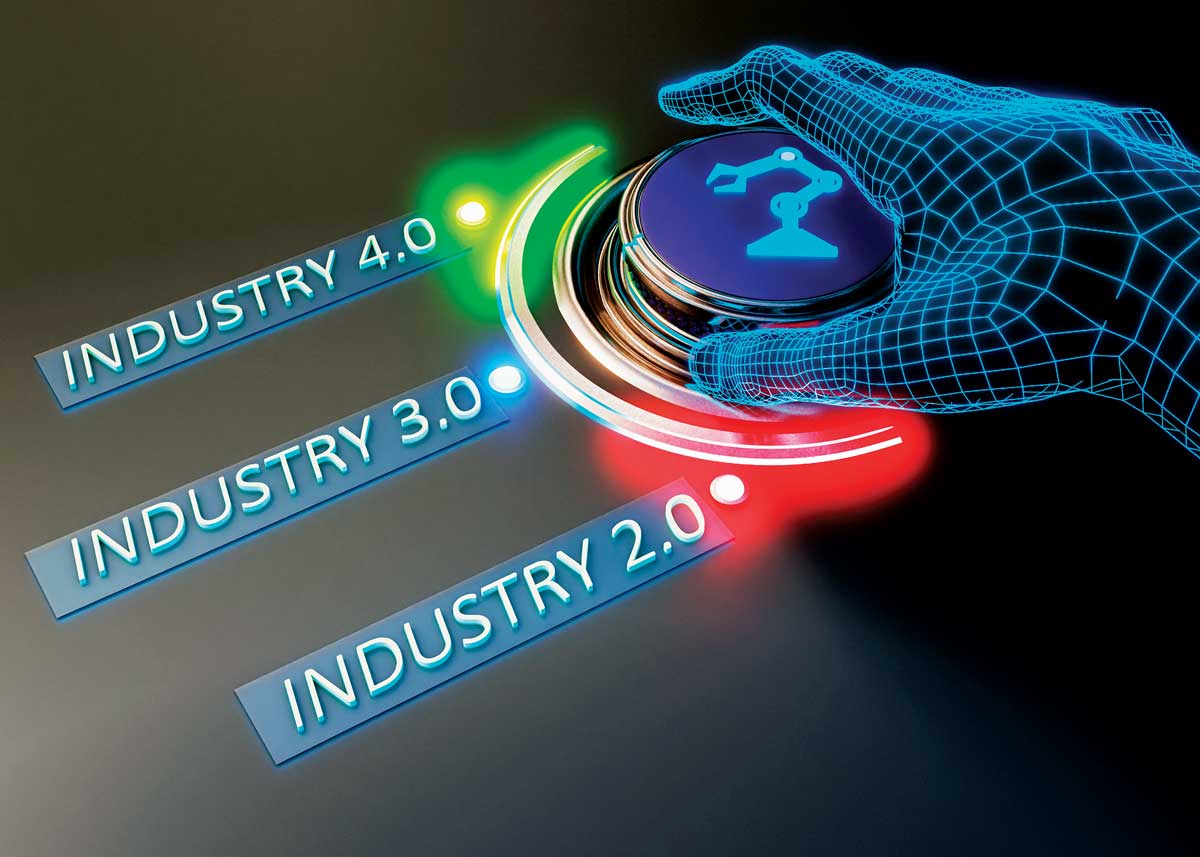We are in the midst of a significant transformation in the way we produce products, thanks to digitisation in manufacturing. This transition is being called Industry 4.0, compelled to represent the fourth revolution that has occurred in manufacturing. From the first industrial revolution, i.e., mechanisation through water and steam power, to the mass production and assembly lines using electricity in the second revolution, the fourth industrial revolution will take forward what was started in the third, with the adoption of computers and automation, and enhance it with smart and autonomous systems fuelled by data and machine learning.Prepare for the futureWhile many organisations might still be in denial about how Industry 4.0 could impact their business or struggling to find the talent or knowledge to know how to best adopt it for their unique use cases, several others are already implementing changes and are preparing for a future where smart machines improve their business.Several companie are preparing for a future where smart machines improve their business.
Data-driven culture is the key to unlock an enterprise’s full performance potential. In the coming 12 months, around 30 per cent of organisations are estimated to invest in data and analytics governance platforms, in pursuit to increase the business impact of trusted insights and new efficiencies. Yet, finding the right technology is just a part of the puzzle. The right information infrastructure will determine how successfully people gather, consume and share data.Seamless hybrid modelWith advances in cloud computing, artificial intelligence (AI) and industrial machine learning, organizations are moving to a hybrid model, combining cloud-hosted SaaS (software-as-a-service) applications with existing on-premises solutions. A hybrid model runs more seamlessly from within a single trusted cloud-based platform. This unification of data across applications provides access to greater actionable insights, enables more collaboration and empowers workforces.Essentials of information platform1. Technology-driven: Empower remote teams with tools designed for enhanced collaboration & productivity2. Data-driven: Data ownership and protection with increased data literacy and data sharing3. Change-driven: Faster pace of change as cloud and AI-infused technologies advancehttps://www.shutterstock.com/image-vector/3d-vector-perspective-infographic-presentation-slide-1856728411The balancing act is quite a challenge for the organisations. They must meet the demand for access to more detailed and accurate real-time data while ensuring that all information coming in and out is secure. The successful development of hybrid SaaS architecture depends only partly on the ability of the technology to deliver. Companies need a foundation in place that aligns secure technology with people and processes while allowing the company to mature on its digital journey at its own pace.Gaining competitive edgeThe digital transformation of industrial sectors will accelerate at an unprecedented pace in the coming years. Organisations that have the right information infrastructure and a data-driven culture in place now are significantly more likely to gain a competitive edge from new technological advances in the future. Those that assume they will be able to fit software around their existing model might risk being left behind. These four pillars provide a guideline for establishing an industrial information system that is trustworthy, secure and reliable.Company’s transition towards a hybrid model is made up of traditional on-premises solutions and newly available cloud-enabled SaaS solutions. This journey begins with establishing a data-driven culture that places clear governance around the acquisition and use of data. Companies must partner with external experts to benchmark their cybersecurity to stay one step ahead of threats. Creating a single estate in the cloud will enable access to multiple applications and facilitate easier data sharing. With proven technologies and expertise, organisations can achieve transformational outcomes, seize every opportunity, and ultimately change the way the organisation thinks and works today and into the future.Transforming infrastructure developmentThe Internet of Things (IoT), although once discussed in laboratories, and technology corporations, has now become a mainstream notion in infrastructure development. Rapid urbanisation, diminishing demand, and a shortage of capital availability had already brought the infrastructure industry to a point of global upheaval. Moreover, the COVID-19 pandemic added to this making it even more challenging for the sector.The infrastructure industry is now becoming more reliant on digital transformation to ensure long-term viability. Almost every aspect of infrastructure is being revolutionised by technology. IoT is generating waves in the infrastructure industry by providing solutions for improving road safety, streamlining traffic management, logistics, mapping use cases, and even supporting future-focused efforts like smart cities. In terms of using digital technology to enhance operations and realise efficiencies, the construction sector has generally trailed behind other industries.IoT and telematics have a huge impact in construction sector, especially at places where legacy systems are hard to replace. One of the biggest challenges for many construction companies, fleet operators and large OEMs is the challenge of efficiently deploying, managing and monitoring the entire fleet of vehicles and machines in the most efficient manner. A robust data basis is needed for planning and this becomes a major bottleneck for organisations due to the diversified fleet of vehicles, models and machines with different manufacturers.Embracing modern technologiesModern construction machines need to embrace modern technologies. A comprehensive IoT platform focussing on telematics and traceability solutions with complete analytics on various operational parameters, machine performance will be of immense support. The sophistication of key technologies for attaining these aims is continuously increasing. Drones can create 3D models of building sites, calculate the area and volume of land to be moved, schedule the job, and even drive autonomous onsite construction equipment using machine learning. Drones are also used for diagnostic purposes, such as evaluating difficult-to-reach areas like pipelines and sub-level infrastructure.Robotic Process Automation (RPA) is capable of enhancing the efficiency of project construction and delivery. Many operations slowed or came to a complete halt during the pandemic. In order to achieve project deadlines and remain competitive, mixed fleet operators will need to enhance their efficiency. It is critical to have a scalable, stable, and adaptable IoT cloud platform, especially when any outage can cause project delays and even client loss.Rethinking business strategiesThe IoT infrastructure industry is expected to develop due to rising investments in smart city initiatives throughout the world. Smart cities provide a variety of connection and computing alternatives that may be added to an existing system to improve efficiency. These technologies are used to address problems in municipal transportation, energy management, and construction. Cities that use IoT solutions may leverage technology and data to enhance infrastructure and services. The growing demand for optimal resource usage in metropolitan settings has accelerated industrial adoption.The infrastructure industry would be revolutionised by digitalisation. It will result in rethinking of business strategies, reimagining of customer offering, and a change in the kind of employment opportunities in infrastructure. For the businesses to benefit digital transformation cannot be limited to a single team, but must be implemented across the board. In order to maximise the benefits, it must be extended all the way to the supply chain.Infrastructure and construction companies are increasingly being pressed to reduce their environmental impact. This will pave way for better resource management as well as waste reduction and CO2 emissions. It will also be critical to build infrastructure that is more efficient in the long run. Emerging technology can aid in the development of new building materials that are more environmentally friendly, have a lower carbon footprint, and are more durable, resulting in less waste and less frequent replacement or upgrading.Impact on manufacturingMany manufacturing plants are today taking advantage of Industry 4.0 principles and technology, as its impact is quite huge. Sensor technology, to an extent, is the backbone of Industry 4.0, enabling the near real-time monitoring and data collection that drives data analysis and more informed, effective decision-making for maintenance, process control, inventory, and management. To be most effective, every piece of equipment in the facility needs to be equipped with monitoring sensors. While these sensors are standard on new equipment, older machinery can also be retrofitted to take advantage of the benefits.Networking technology also plays a major role in the effects of Industry 4.0. Although discrete communication between equipment and systems has been present for quite some time, Industry 4.0 represents a huge leap. This momentum has resulted in a fully interconnected facility where all equipment feeds data into software systems that allow for nimble, effective decision-making at macro and micro levels.Even though automation is not new in manufacturing, Industry 4.0 advances automation technology even further. This technology enables more informed programming, more innovative ways of people and robots working together, and an overall increase in efficiency, safety and productivity.With the massive amount of data being collected in real-time, areas such as process control become more effective with the ability to fine tune and adjust more effectively. One of the main advantages of Industry 4.0 data analytics is reliability centered maintenance, including predictive maintenance that reduces downtime, increases productivity and keeps the facility operating at peak performance.(infographic)Five ways Industry 4.0 manufacturing equipment can increase efficiency:1. New sensor technology can provide better insight into predictive maintenance & helps eliminate disruption resulting from equipment failures.2. With automated processes, production can keep going around the clock, leading to higher production volumes and faster delivery.3. Data gathering and analysis is a big part of Industry 4.0 and helps companies compile data to optimise their processes.4. Companies operating under circular manufacturing mentality are focused on sustainable practices that eliminate waste.5. With Industry 4.0 technologies, companies can ensure reliable quality management over their products.https://www.shutterstock.com/image-vector/modern-infographic-business-template-591502346Shaping the futureThe future of manufacturing is being shaped by advances in automation and robotics, artificial intelligence, Internet of Things, and 3D printing. These technologies are forecast to increase manufacturing efficiency, reduce waste, and drive down costs. Companies are predicted to increasingly adopt Industry 4.0 technologies and methodologies including smart factories and decentralised decision making.Manufacturers will need to evaluate where they are, and where they want to be, as the integration of information technology and operations technology develops. These decisions will determine the types of information they will need to gather, analyse, and act on. Organisations can understand which types of information will be most pertinent to them as they seek to transform their business operations, growth, or both by integrating the information identified through the information value loop, where the focus lies along the manufacturing value chain.Understanding how the physical can influence the digital and vice versa is essential to the realisation of Industry 4.0.Expert’s Speak:“The future of warehousing depends on the integration of IT with the processes in place to ensure that maximum throughput is seen at higher efficiency levels to bring down the overall costs and improve the effectiveness of the service offerings. Artificial intelligence (AI) has already started playing a major role in improving efficiencies in warehouses. The more successful larger companies throughout the logistics sector may gravitate towards artificial intelligence, blockchain, and other technological solutions to help solve the present cash crunch and other problems.”- Adika Ratna Sekhar, CMD, Balmer Lawrie & Co. Ltd.“IIoT has been an important part of any equipment. It has become a lifeline to get meaningful output from machines. We have the Cybertronic software that allows remote control of the plant and troubleshooting. With this technology, we are also able to provide suggestions to improve the output of our machine. We are also working to connect plants through cloud computing.”- Sanjeev Kumar, CEO, Marini India“We expect IoT and analytics to gain more traction. Preventive maintenance will help the machines perform better, reducing downtime. All of these are part of Industry 4.0 along with robotics and automation. We also expect more standardisation coming up.”- Nirag Chokshi, Managing Partner, TACKLERS, Techno Industries“Technology is already been implemented in many areas, but civil engineering has been the last to adopt technology and mechanise things. Manufacturing in domains like pharma, automobiles, etc., automation has become a norm, with robotics and IoT coming into the picture. But civil industry is still a little bit behind in terms of adopting technology in a big way. Looking at the construction industry in India, technological intervention is only about 1%. Technology adoption happens when the real benefits are felt by the market, in terms of reduction in material, manpower, and time.”- Shridhar Rao, Sales Head-India, Elematic India Pvt Ltd


















